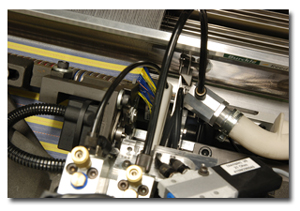The Switzerland-based International Textile Manufacturers Federation (ITMF) has released its 32nd
annual International Textile Machinery Shipment Statistics (ITMSS) report, covering spinning,
texturing, weaving, large circular-knitting, flat-knitting and finishing machinery. Compiled with
the participation of some 112 textile machinery manufacturers around the globe, the survey
represents a comprehensive evaluation of world production, according to ITMF.
ITMF reports that as in 2008, 2009 saw a sharp reduction in global shipments of new textile
machinery in most segments, with only texturing spindles and circular knitting machines recording
increases. The organization attributes this continued decline mainly to the effects of the global
financial and economic crisis.
Spinning
Global shipments of short-staple spindles in 2009 dropped by 17 percent to 7.2 million
spindles, following a much larger drop of 33 percent in 2008. Asia absorbed 7 million or 97 percent
of all short-staple spindles, with China installing 5.04 million or 70 percent of global shipments;
followed by India, 1.37 million or 19 percent; Vietnam, 111,000 or 1.5 percent; Bangladesh, 108,000
or 1.5 percent; Myanmar, 89,000 or 1.2 percent; Turkey, 85,000 or 1.2 percent; and Turkmenistan,
82,000 or 1.1 percent.
Long-staple spindle shipments plunged in 2009 to 32,000, a 78-percent drop. Shipments to Asia
fell by 85 percent to 16,800. Shipments to Europe, including Turkey, decreased by 43 percent to
10,600, and shipments to South America decreased by 30 percent to 4,600. As in the previous year,
2009 saw no investments in long-staple wool spindles in Africa or North America.
Following a significant 2008 decrease of open-end (OE) rotor investments, 2009 investments in
OE rotors also fell, decreasing 26 percent to 144,500. Asia absorbed 120,300 or 83 percent of OE
rotors. China installed 79,000 or 55 percent of global shipments; followed by India, 12,600 or 9
percent; Brazil, 11,500 or 8 percent; Kazakhstan, 6,400 or 4 percent; and Indonesia, 6,100 or 4
percent.
Texturing
Shipments of single-heater draw-texturing spindles for polyamide filaments fell by 45 percent
to 2,880 in 2009. China and Korea were the only investors in this type of machinery, with 2,640 or
92 percent, and 240 or 8 percent, respectively. Shipments of double-heater draw-texturing spindles
for polyester filament increased by 52 percent to 248,000, back to 2007 and 2006 levels. China
again led the investments, with 139,00 new spindles or 56 percent; followed by India, 41,500 or 17
percent; Thailand, 16,300 or 7 percent; Brazil, 10,500 or 4 percent; and Russia, 3,200 or 1.5
percent.
Weaving
Investments in shuttleless looms decreased in 2009 by 3 percent to 43,300 machines, the
lowest level since 2000, the year shipments from China’s textile machinery manufacturers were first
included in the survey. Asia absorbed the largest number of shuttleless looms, with 41,750 or 96
percent. China installed 25,600 or 59 percent of total shipments in 2009; Bangladesh, 8,400 or 19
percent; India, 3,450 or 8 percent; Indonesia, 1,760 or 4 percent; and Vietnam, 750 or 2 percent.
Circular And Flat Knitting
Circular knitting machine shipments recorded a 20-percent increase to 25,450 over 2008
shipments — the fourth-highest level since 2000 and significantly higher than pre-2004 levels.
Taking 85 percent of shipments, Asia led in investments in circular knitting machines. China
recorded 17,600 or 69 percent of global shipments; Mauritius, 2,300 machines or 9 percent;
Bangladesh, 840 or 3.5 percent; India, 570 or 2 percent; Brazil, 540 or 2 percent; and Korea, 360
or 1.5 percent.
Shipments of electronic flat knitting machines in 2009 were down by 12 percent to 17,840.
Asia received 90 percent; Europe, including Turkey, received 9 percent. China received 10,690
machines or 60 percent; Hong Kong, 4,320 or 24 percent; Italy, 900 or 5 percent; Turkey, 470 or 3
percent; and Cambodia, 200 or 1 percent.
ITMF states the 2009 ITMSS report includes statistics on finishing machinery, however, it did
not include any details about this data in its summary.
June 29, 2010





